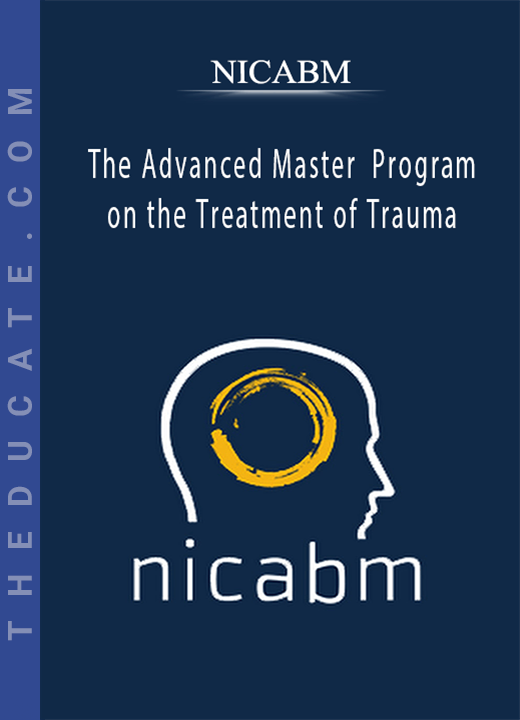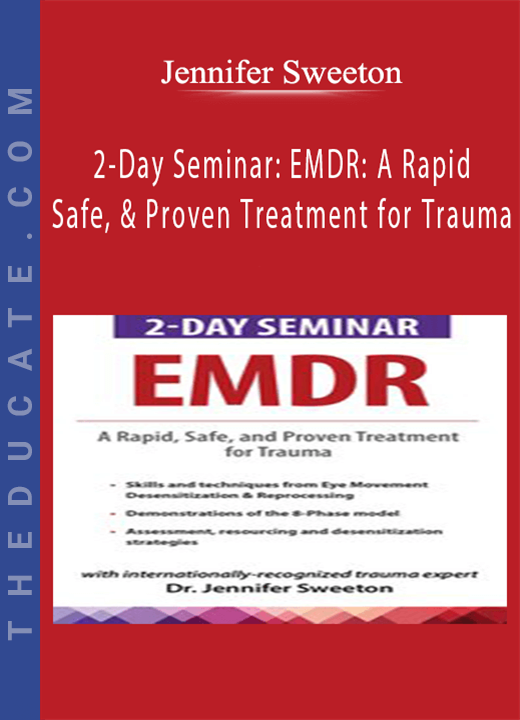Description

Nicabm – The Advanced Master Program on the Treatment of Trauma
“NICABM – The Advanced Master Program on the Treatment of Trauma” is an intensive program designed by the National Institute for the Clinical Application of Behavioral Medicine (NICABM). This advanced master program focuses on equipping mental health professionals with cutting-edge techniques and strategies for effectively treating trauma. Participants delve into the latest research and clinical practices related to trauma therapy, learning innovative approaches to assessment, intervention, and long-term recovery. The program emphasizes a comprehensive understanding of trauma’s impact on individuals and communities, providing participants with the tools to deliver evidence-based care and support to trauma survivors.
Treating trauma is some of the most demanding, complex work we do.
When a patient has experienced trauma, many of the ways we’ve been trained to establish safety and build rapport may fail us.
For a client who’s experienced trauma, relationships might feel unsafe. Eye contact can be frightening.
Perhaps most challenging, patients can get easily triggered during their session.
When this happens, their nervous system gets flooded, cognition is knocked offline . . .
. . . and they may not be able to process much in words.
At this point, cognitive behavioral approaches, psychoeducation, and insight-based techniques become ineffective, or even counterproductive.
But the way we understand trauma and how to treat it has evolved, even in the last several years.
We’ve gone beyond the traditional fight/flight/freeze model, and we’re learning how to work with additional defensive adaptations that clients make to survive trauma.
We’re finding new strategies that help clients feel safe and grounded at the level of the nervous system.
We have fresh insights into how to help patients whose trauma history is derailing their current relationships – the very relationships that can be powerful sources of strength, comfort, and support as they heal.
And we’re learning how to identify and work with the subtle (as well as obvious) ways that clients dissociate . . .
. . . as well as the equally subtle micro-interventions that can help your client come into the present and become a more stable, emotionally mature adult – capable of intimacy and flexibility, and equipped to see the world with nuance.
When we’re able to help clients rewire their trauma response,
it can have a profound effect on healing.
Promising clinical research and evidence-backed strategies can lead our practice in new directions.
That’s why we’ve developed an advanced program that gathers all the latest information on the treatment of trauma . . .
. . . and we’re calling all practitioners, all over the world, to join us for the next five weeks as we focus on the latest findings on trauma and its treatment.
Introducing the Advanced Master Program on the Treatment of Trauma
How to Work with Emerging Defense Responses to Trauma (Beyond the Fight/Flight/Freeze Model)
Pat Ogden, PhD Stephen Porges, PhD Bessel van der Kolk, MD
Janina Fisher, PhD Kathy Steele, MN, CS Deb Dana, LCSW
Ruth Lanius, MD, PhD Thema Bryant-Davis, PhD
- 3 Alternative Defense Responses to Fight-Flight-Freeze (and How to Identify Them)
- The Profound Impact These Defense Responses Can Have on Your Client’s Relationships
- The Least Understood Defense Response – and Why It May Produce the Opposite of What Your Client Wants
- Why These Defensive Responses Can Leave Your Client Vulnerable to Further Trauma
- A Polyvagal-Informed Approach to Working with Defense Responses
How to Identify and Treat Dissociation (Even When It’s Subtle)
Peter Levine, PhD Ruth Lanius, MD, PhD Stephen Porges, PhD
Bessel van der Kolk, MD Thema Bryant-Davis, PhD
Kathy Steele, MN, CS Janina Fisher, PhD
Bethany Brand, PhD Pat Ogden, PhD
- Key Signs and Symptoms That Let You Know Your Patient Has a Tendency to Dissociate
- Structural Dissociation – What It Is and 3 Distinct Ways to Work with It
- How Trauma Affects the Brain and Body – and Why That Can Lead to Dissociation
- Common Mistakes That Stall Treatment with Clients Who Dissociate
- Two Difficult Challenges of Working with Dissociation – and How to Overcome Them
- When Dissociation Is Triggered in a Medical Environment: Key Considerations for Medical Professionals
How to Ease the Pain of Trauma-Induced Shame
Bessel van der Kolk, MD Ruth Lanius, MD, PhD Peter Levine, PhD
Thema Bryant-Davis, PhD Richard Schwartz, PhD Pat Ogden, PhD
Janina Fisher, PhD Kathy Steele, MN, CS Stephen Porges, PhD
Martha Sweezy, PhD, LICSW Deb Dana, LCSW William Nash, MD
- How to Recognize Shame Even When Clients Don’t Think It’s a Problem
- Four Defenses Clients (and Sometimes Therapists) Use to Manage Shame
- How Cognitive Approaches to Shame May Backfire and What to Try Instead
- Two New Findings on the Neurobiology of Shame (and Their Clinical Impact)
- How to Work with Moral Injury and Why Resolution Is Essential for Healing
- Why Some Clients Get Triggered by Positive Emotions (and How to Help Them Safely Experience Positive Emotions Again)
How to Work with Patients Whose Trauma Triggers Problems in Their Current Relationships
Stephen Porges, PhD Terry Real, MSW, LICSW
Janina Fisher, PhD Richard Schwartz, PhD Pat Ogden, PhD
Martha Sweezy, PhD, LICSW Bessel van der Kolk, MD
Ruth Lanius, MD, PhD Deb Dana, LCSW Thema Bryant-Davis, PhD
- An Important Issue That Must Be Addressed BEFORE You Can Build Your Client’s Relationship Skills
- How to Help Clients Speak For, Not From, Their Wounded Inner Part
- An Expert Strategy to Help Clients Understand the Implicit Memories That Fuel Conflict in Their Relationships
- Two Distinct Types of Relational Trauma (and Specific Approaches for Working with Each)
- Why Clients Re-Enact Past Relationships (and How to Help Them Stop the Cycle)
Strategies to Treat Patients Trapped in the Freeze Response
Bessel van der Kolk, MD Stephen Porges, PhD
Ruth Lanius, MD, PhD Pat Ogden, PhD Thema Bryant-Davis, PhD
Bethany Brand, PhD Deb Dana, LCSW Janina Fisher, PhD
Kathy Steele, MN, CS
- The First Thing to Do When You Recognize Your Patient Is in Freeze
- Clear-Cut Interventions for Bringing a Client Out of Freeze During a Session
- What NOT to Do When Your Patient Is Frozen
- How to Work with the Freeze Response at the Level of the Nervous System
- How to Help Patients Identify What Triggers Their Freeze Response
- A Four-Step Process That Can Help Patients Regulate Their Freeze Response
- A Simple Biofeedback Strategy That Can Help Patients Gain a Sense of Control Over Their Freeze Response
With this Program You’ll Get:
 |
Downloadable videos and audios to watch or listen to when it’s convenient for you |
 |
Critical Insights sessions to distill key ideas (this is where we “land” the module) |
 |
Focus on Application sessions to give you concrete strategies to use with patients |
 |
Printable QuickStart Guides to make review and action simpler than ever |
 |
Professionally-formatted transcripts of the sessions |
 |
Downloadable videos, audios, and transcripts of the bonus |






7 reviews for Nicabm – The Advanced Master Program on the Treatment of Trauma
There are no reviews yet.